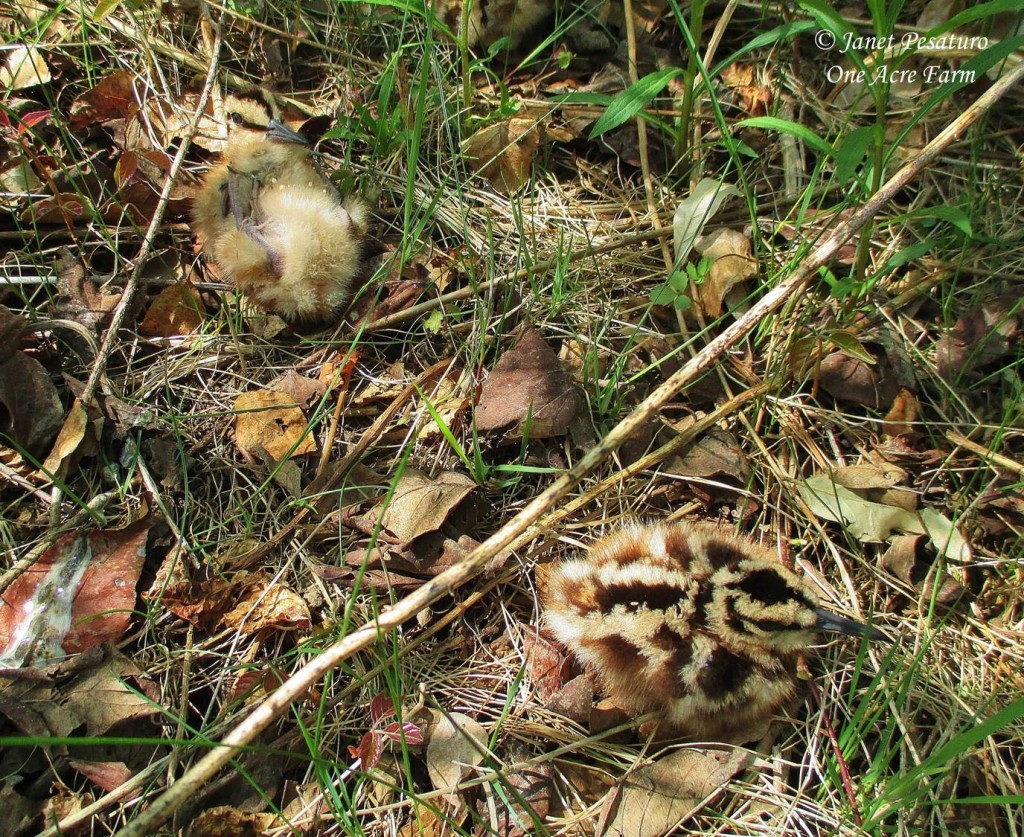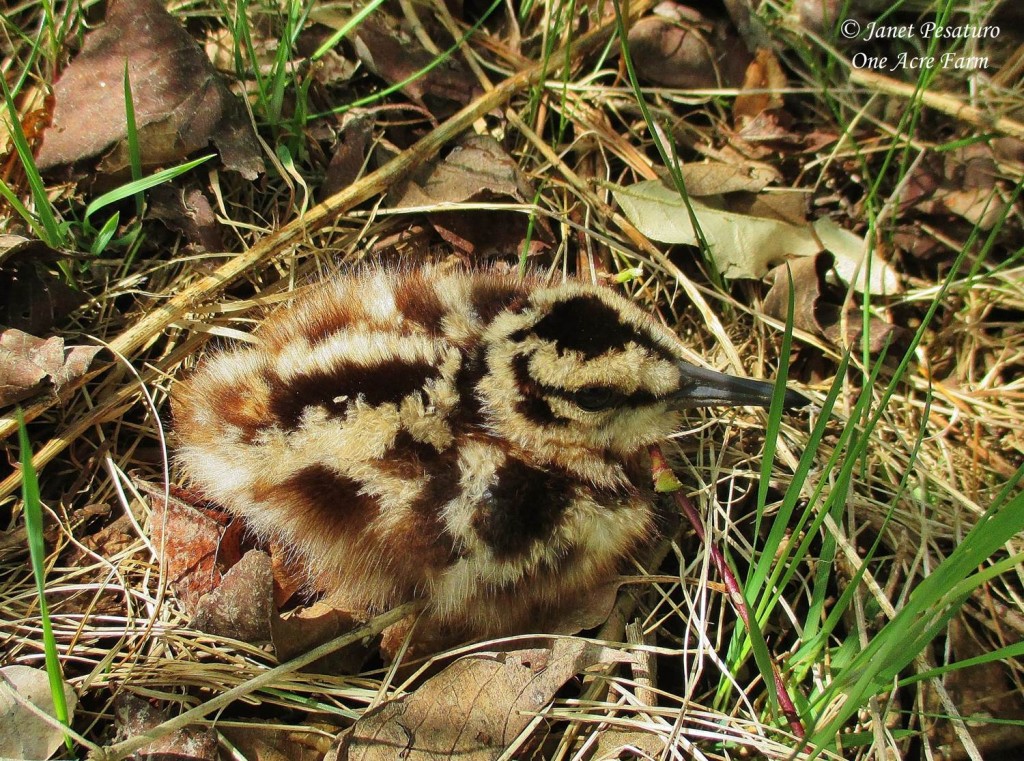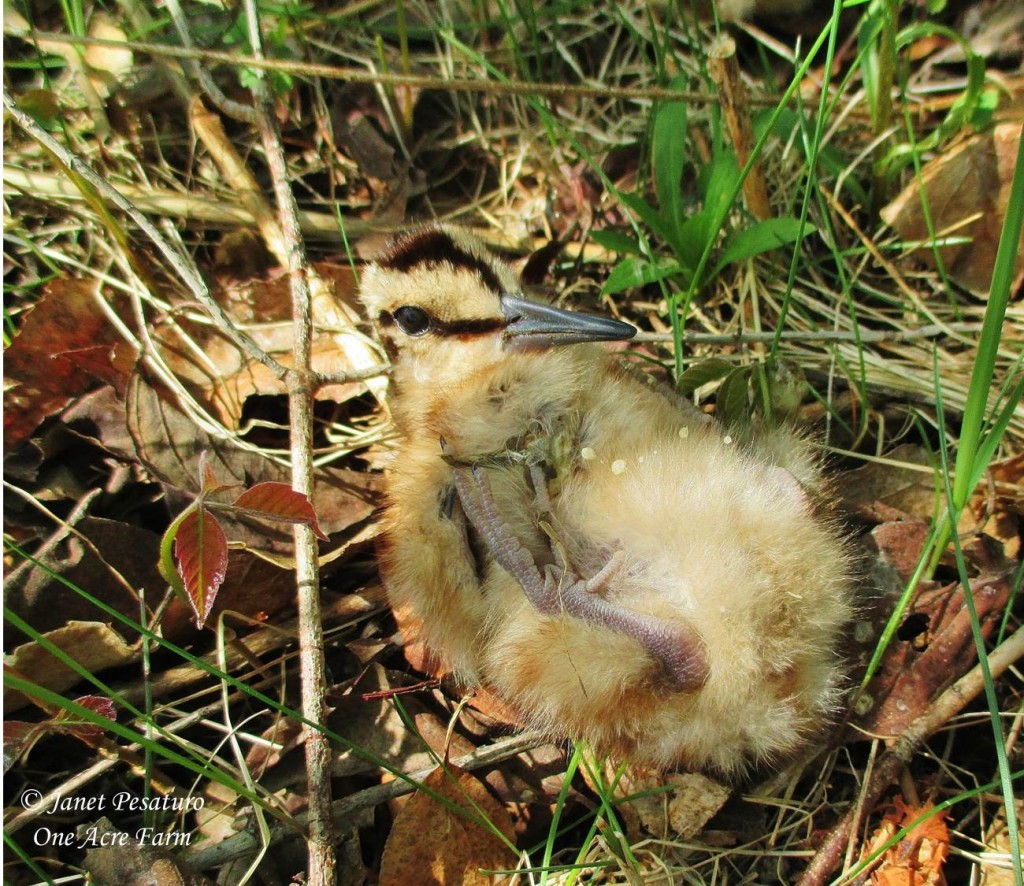These little American woodcock chicks are my cutest find so far this spring. The woodcock is actually in the shorebird family, but it doesn’t occupy the typical habitat of its coastal cousins. It lives in shrubby old fields and very young forests, and ranges over the eastern US and southeastern Canada, as you can see here.
I happened upon this nest while traversing a wide swath of brush sandwiched between a cornfield and a pond. Suddenly, a bird exploded from under my nose, and there at my feet were these two sweet little chicks. Notice how well camouflaged they are.

American woodcock chicks, after I accidentally flushed their mother. Her sudden take off must have sent the chick on the left rolling.
The mother must have been brooding the chicks when I startled her. Her sudden take off must have sent one of the chicks rolling – the one in the photos lying belly up with its feet up in the air. Not wanting to stress out this little family, I snapped 3 photos and hurried away. Of course, now I regret not staying just a few minutes longer to get some better shots…
A prehensile bill
One of the giveaways to the identity of a woodcock chick is its long bill. See the adult bird here. These birds use their long bills to probe for earthworms, which make up a large part of their diet. In fact, the upper portion of the bill is prehensile – its flexibility makes it more efficient in finding and harvesting worms.
Woodcock decline and conservation challenges
Like many birds, the woodcock is in decline. Its population has dropped about 1% per year since the 1960’s, and the reason is loss of brushy habitat. The solution would be to create brushy habitat, but there are a few stumbling blocks to that:
- Public disapproval of clear-cutting forest, which is the best way to create shrubland habitat.
- Non-native invasive shrubs tend to establish in clear cuts, and removing them and restoring native shrubs is extremely expensive.
The brushy area where I found this nest was indeed comprised largely of invasive multiflora rose and honeysuckle. But the woodcocks didn’t seem to mind.
Shared on: Simple Life Sunday, Heritage Homesteaders Hop #12, Homestead Barn Hop #160, HomeAcre Hop #71, Backyard Farming Connection #82, Mountain Woman Rendezvous #48













I also found two woodcock chicks once, after flushing their mother. So adorable! I’m glad to know our brushy land is good habitat for them–it’ll make me more tolerant of all the blackberry brambles. 🙂
That’s great, Kellyann. It’s always exciting to find chicks of any kind of bird. Brushy habitat can be messy and impenetrable, but there are a lot of species dependent upon it. You are lucky to have blackberry. If I had a choice of brush plants, black berry brambles would be high on the list – native, and great food value for both humans and wildlife.
What a find! I once startled an adult off her nest but I have never found babies – pretty darn neat! 🙂
Thanks, it was pretty cool. I must say, the chicks were so well camouflaged that I almost missed them, even having just flushed the mother. And if she hadn’t been there to be flushed, I might have accidentally stepped on the poor things!
What a wonderful find! Glad you were able to snap a few pictures. Thank you for sharing your post on the HomeAcre Hop, hope to see you again tomorrow! – Nancy
The Home Acre Hop
Thanks, Nancy.
I rescued a lone chick yesterday afternoon on the highway. I waited about ten minutes with no sight nor sound of any others. Its mother and a sibling had been road-kill.:( I’ve been feeding him/her bloodworms I use for my tropical fish. Feedings are hourly and I plan on staying up all night to care for this little one. Will try the Ministry of Natural Resources in the morning. It would be best for him to be able to return to the wild. Otherwise I’ll be knitting a harness for him and going for walks!! Lol
Oh, my goodness, kdyas! How kind of you to take care of this little chick. I would love to know what the Natural Resources folks have to say about re-introducing it to the wild, so please let me know, if you receive this message!
I like the valuable info you provide in your articles.
I will bookmark your weblog and check again here frequently.
I’m quite certain I’ll learn lots of new stuff right here!
Best of luck for the next!
All chocolate comes from the seeds or beans of the cacao fruit.
When you receive your product, read the label carefully before opening.
Be aware it does not work on its own, so it is still
up to you to eat a healthy and well balanced diet.
Thank you a bunch for sharing this with all people you really know
what you are speaking about! Bookmarked.
HI I found adult woodcock in front of my home, moving very slow, it seems like looking for food but covered by snow few days ago. so I thought it would be dangerous if it left behind during night without no food and cold, so I’m taking care of it now, i left water and berries but i don’t know if it is eating or not. I’d like to let it go to wild, but worries if it will die b/c still snow covered yard, and very cold. What should I do?
I’m thinking remove snow on my backyard and let it find some food from the ground but isn’t it too cold out side still? i’m living north bergen county NJ. snow storm this Saturday as well.
thanks.
Jin
Hi Jin, I would leave it in the wild to fend for itself. They are year round residents in the southern half of NJ, so you are really just over the boundary of its year round range. Woodcocks can deal with some snow and cold. Perhaps it just returned to your area and needed a few days to catch its wind. Sometimes birds are really tired after migration.
However, if you have had it indoors for several days or more, it might have trouble re-acclimating to the colder outdoor temperatures. In that case, I would call a wildlife rehabilitator and ask for advice.
A woodchuck has been around my shrubs for about a week now..Nova Scotia Canada.
Then 2 days ago we got a lot of snow. The bird seems very sluggish. Is there something I can do to feed it or keep it warm. I put out bread and milk. Have no access to worms.